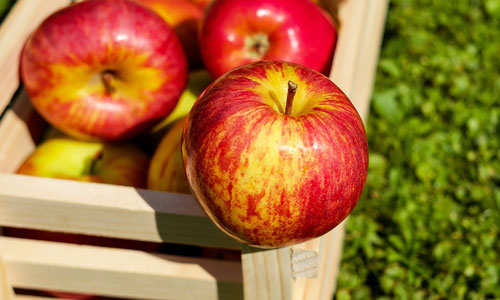With the fall season almost underway, what better time to consider the apple industry as subject matter for your agribusiness coverage. This blog outlines some of the main themes and business stories to bite into.
Grab the data
Did you know the United States has 7,500 apple producers and produces 240 million bushels of apples a year on 322,000 acres of land? Another gem: The wholesale value of America’s apple crop each year nudges $4 billion — and that’s not including the additional $14 billion downstream economic activity that comes from apples each year.
This data comes from the U.S. Apple Association, a trade group whose website contains all kinds of facts and figures to help you create a compelling nut graph for any trend or business story on the apple industry.
Get a handle on the geography
As you’re digging for business stories, understand the regions where apples remain most abundant. While 32 states within America grow apples commercially, the most profitable remain:
- Washington
- New York
- Pennsylvania
- Michigan
- Oregon
- California
- Virginia
- North Carolina
- Ohio
- Idaho
Even if you don’t live within these regions, learn the number of apple producers within your state and tap your local college of agriculture and apple board to understand their strengths and challenges. No business feature on any crop does well without interviews from those growing, and supporting, the products.
Understand how U.S. apples rank internationally
Few realize that the U.S. produces the world’s second-largest supply of apples after China — followed by Poland, Italy, and France. With that surplus of apples, challenges and triumphs exist. For instance, one out of every four apples produced domestically is exported; Mexico, China, India and Hong Kong are the major importers. In spite of our surplus, our production downtime creates a dearth of apples in our supermarkets, which means we must import apples too. While the U.S. Apple Association states only 5 percent of all apples consumed in the States come from international sources, this supply is linked closely to the economies of the countries from which we import: New Zealand, Chile and Canada. Demand for New Zealand apples is soaring, reports say.
Monitor the news stories on apples
A quick Google search yields some interesting business stories on apples. For instance, India’s production is down this year due to weather woes and public disorder offsetting production in one of the country’s largest apple states. Virginia, America’s fifth-largest producing state, also suffered from dropped apple production this year due to freeze damage. Look for sustainable business angles. For instance, Walmart recently began stocking irregular-shaped apples in an attempt to offset a chronic problem across the states of food waste. Also, consider the new varieties coming into the market including the red-fleshed, super vitamin-charged apples featured in the Guardian Sustainable Business.
Reporter’s Takeaway
- Use data from the U.S. Apple Association to make a compelling nut graph.
- Even if you’re not reporting from an important apple-producing state, there’s probably a regional story; try tapping into a local agriculture school.
- Consider agro-business stories with a weather angle; look into retailers’ new marketing tactics; investigate the science of vitamin-charged apples.











